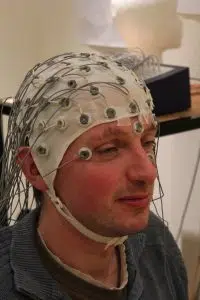Many people equate seizures with Epilepsy, but the two aren’t mutually exclusive.
While having epilepsy does mean you suffer from seizures, having a seizure doesn’t mean you have epilepsy.
Jayme Chami, the Public Educator for Epilepsy Southwestern Ontario says there’s a very specific difference.
“Everybody has neurons in their brains. They are the cells that are the communicators. So, we have billions of them… Sometimes they get a little bit confused, we say, and they will misfire. So, when neurons misfire in the brain somebody will have what’s called a seizure.”
“So what is epilepsy? Epilepsy is when [neurons misfire] more than 2 times… People also have epilepsy if they’ve had one seizure in the brain as well as a positive EEG.”
An EEG (Electroencephalogram) is a test that detects activity in the brain. Metal discs (electrodes) are attached to the scalp and the electrical signals the brain produces are measured by computers.
EEGs aren’t always the best way to test for epilepsy, because there’s a big chance it can register a false negative. If the neurons don’t misfire while a person’s hooked up for the test, it won’t register anything abnormal.
There are other reasons someone can suffer from a seizure:
- a mental health problem, like an emotional conflict or stress
- extreme high or low blood sugar
- really high fever (especially in children)
- cysts
- tumors
- PNES psychogenic seizures
Whether a seizure is caused by misfiring neurons or not, if a person has had a seizure in their lifetime they’re 50% more likely to have another, then someone who’s never had one.
Chami says there are more than 30 different types of seizures.
“There’s two main that we usually talk about. So, first there’s focal seizures and then generalized seizures. Focal seizures are when a person’s neurons misfire in just one spot of the brain… That can look different, the person can be either aware or unaware.”
Someone can be completely aware of a seizure, for example their arm could be shaking, but there’s nothing they can do about it.
Sometimes a person can be suffering a seizure and nobody else can tell, like the taste or smell of burnt toast. These are called sensory non-motor.
Focal unaware seizures means the person experiencing the seizure is confused and has impaired awareness. This could mean anything from wandering around a room, to picking at clothing, to flicking a light switch without knowing it. These people may answer you if you talk to them, but they likely won’t remember anything about the conversation.
Chami says generalized seizures occur when neurons misfire over the whole brain.
“During these types of seizures people can’t see, hear, taste, or feel pain. They won’t remember the seizure.”
These are the types of seizures people are more familiar with.
They include Petit Mal Seizures, which have been renamed and are now known as Absence Seizures. This type of brief seizure causes lapses in awareness or staring, and are often thought of as daydreaming.
Another type is Grand Mal, which are now known as Tonic-clonic Seizures. Tonic means stiffen, while clonic means shake. It’s the most familiar type of seizure and is when the body starts to convulse.
If you see someone having a seizure, Chami says the number one thing to remember is to stay calm.
“Most seizures aren’t a medical emergency.”
If someone starts convulsing try to lay them down on their side (in case of vomiting) and put something soft under their heads.
And always time a seizure. Chami says the 5 minute mark is when you need to call 911.
“Call at 5 minutes, not because we’re worried about 5 minutes. We’re actually worried about 30 minutes. At 30 minutes there’s a risk of brain injury. We want to make sure the paramedics get there in between that time.”
She adds that things you never want to do is try to hold a person down or put something in their mouth.
The most important thing to remember is that regardless as to whether a person suffers seizures or epilepsy, they still live normal, happy lives.
To learn even more about seizures and Epilepsy, listen here:









